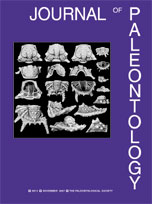Nine species, including two new species of decapod crustaceans, are described from the Paleocene Rancho Nuevo Formation, collected from two localities of the Parras Basin, southeast Coahuila state, Mexico. The astacid Enoploclytia gardnerae (Rathbun, 1935) is represented by a pair of large chelae and one cephalothorax. An incomplete nephropid carapace is identified as Enoploclytia sp. Partial specimens of a callianassid and a pagurid are described. One partial carapace representing Linuparus wilcoxensis Rathbun, 1935 is described. A new raninid, Macroacaena venturai new species extends the genus into Mexico. Paraverrucoides alabamensis (Rathbun, 1935) is the most abundant species, followed by Tehuacana tehuacana Stenzel, 1944 and Viapinnixa perrilliatae new species. Taxonomic affinities of this assemblage confirm influence of the Mississippi Embayment, particularly from Paleocene stratigraphic units of Texas and Alabama.
How to translate text using browser tools
1 November 2007
PALEOCENE DECAPOD CRUSTACEA FROM THE RANCHO NUEVO FORMATION (PARRAS BASIN-DIFUNTA GROUP), NORTHEASTERN MEXICO
FRANCISCO J. VEGA,
TORREY NYBORG,
RENÉ H. B. FRAAYE,
BELINDA ESPINOSA
ACCESS THE FULL ARTICLE

Journal of Paleontology
Vol. 81 • No. 6
November 2007
Vol. 81 • No. 6
November 2007




